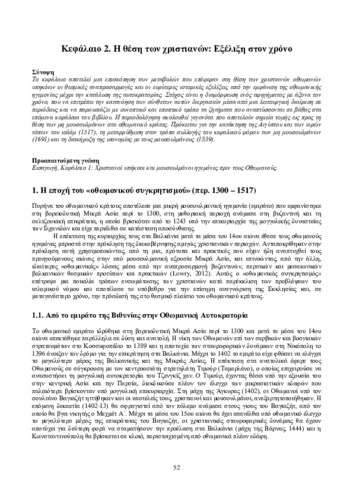| Title Details: | |
|
The position of Christians |
|
| Other Titles: |
A timeline |
| Authors: |
Gkara, Eleni Tzedopoulos, Giorgos |
| Reviewer: |
Stamatopoulos, Dimitrios |
| Subject: | HUMANITIES AND ARTS > HISTORY > GENERAL HISTORY, THEORY > OTTOMAN HISTORY HUMANITIES AND ARTS > HISTORY > SPECIALIZED HISTORIES HUMANITIES AND ARTS > HISTORY > GENERAL HISTORY, THEORY > MODERN HISTORY |
| Keywords: |
Christians
Muslims Ottoman Empire Church Islamisation Syncretism Intercommunal Relations Confessionalization Conversion |
| Description: | |
| Abstract: |
This chapter is an overview of the changes in the position of Christians in the Ottoman Empire brought about by historical adjustments and wider developments, from the emergence of the Ottoman principality until the dissolution of the empire. The aim is to develop a time-centered narrative that, on the one hand, allows the understanding of these complex processes through a functional division into periods, and, on the other, presents in a concise and comprehensive manner the issues developed in depth in the following chapters of the book. The periodization follows events that mark a watershed in the position of non-Muslims in the Ottoman state, namely the conquest of Egypt and the holy places of Islam (1517), the reform in the collection of the poll tax for non-Muslims (1691) and the proclamation of equality before the law for all subjects (1839).
|
| Table of Contents: |
1. The era of "Ottoman syncretism" (ca. 1300-1517)
1.1. From the emirate in Bythinia to the Ottoman Empire 1.2. Political structure of the Ottoman emirate 1.3. The syncretistic terms of expansion 1.4. Christians in the early Ottoman state 1.5. The fall of Constantinople: Rupture and continuity 1.6. The end of early Ottoman syncretism 2. Ottoman confessionalization (1517-1691) 2.1. The empire of three continents 2.2. Turn toward the Sunni orthodoxy and the position of Christians 2.3. Consolidation of the institutional subordination of non-Muslims 2.4. From recovery to crisis 2.5. Islamic zelotism and its consequences 3. Disjunction of religious communities (1691-1839) 3.1. Gradual retreat of the Ottomans 3.2. The caesure of the tax reform of 1691 3.3. Intercommunal relations: estrangement and introversion 3.4. Rise of new Christian strata 3.5. The shaking of the old order 3.6. Delegitimation of the Ottoman rule 3.7. The rupture of the Greek Revolution 4. From religious communities to nations (1839-1923) 4.1. The demand for reforms 4.2. The caesure of the Tanzimat reforms 4.3. The venture of Ottomanism 4.4. The transformation of religious communities to nations 4.4. The road to the dissolution of the empire |
| Linguistic Editors: |
Lampada, Despoina |
| Type: |
Chapter |
| Creation Date: | 2015 |
| Item Details: | |
| License: |
http://creativecommons.org/licenses/by-nc-nd/3.0/gr |
| Spatial Coverage: |
Ottoman Empire |
| Temporal Coverage: |
14th-19th cc. |
| Handle | http://hdl.handle.net/11419/2883 |
| Bibliographic Reference: | Gkara, E., & Tzedopoulos, G. (2015). The position of Christians [Chapter]. In Gkara, E., & Tzedopoulos, G. 2015. Χριστιανοί και μουσουλμάνοι στην οθωμανική αυτοκρατορία [Undergraduate textbook]. Kallipos, Open Academic Editions. https://hdl.handle.net/11419/2883 |
| Language: |
Greek |
| Is Part of: |
Χριστιανοί και μουσουλμάνοι στην οθωμανική αυτοκρατορία |
| Publication Origin: |
Kallipos, Open Academic Editions |


